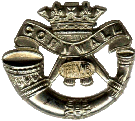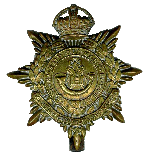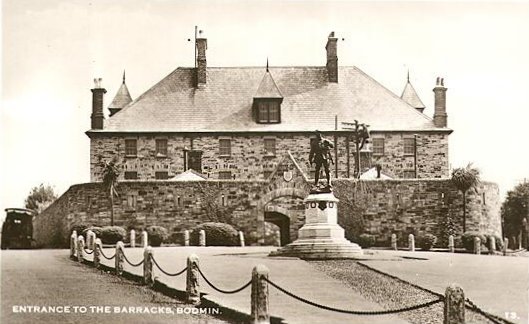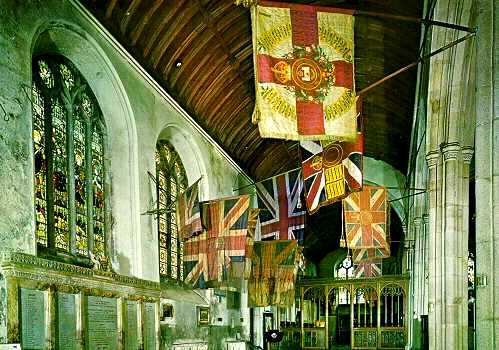
| Movements of the Sixth (Service) Battalion | |
|---|---|
| August 1914 | formed at Bodmin and sent to Aldershot as the 43rd Brigade (14th Division) |
| 14 September 1914 | renamed the 14th (Light) Division |
| 26 September 1914 | inspected on Queen's Parade by the King |
| November 1914 | billeted in the Guildford and Godalming district |
| 22 January 1915 | inspected on Hankley Common by Earl Kitchener |
| 18 February 1915 | sent to Stanhope Lines, Aldershot |
| 11 May 1915 | warned to proceed overseas |
| 18 May 1915 | entrainment began |
| 21 May 1915 | landed at Boulogne |
| 20 February 1918 | disbanded in France |
| Fought in almost every major battle on the Western Front | |
14th (Light) Division was the junior formation of six divisions formed in August 1914 which formed the First New Army. Kitchener's Volunteers were known at the time as "K1" or the first one hundred thousand. Each division consisted of three brigades each of four infantry battalions. In the 14th (Light) Division all the regiments were of the fast marching rifle or light infantry regiments, hence the sub title "Light". The battalions in the 43rd Brigade were:
- 6th Battalion The Somerset Light Infantry
- 6th Battalion The Duke of Cornwall's Light Infantry
- 6th Battalion The Kings Own Yorkshire Light Infantry
- 10th Battalion The Durham Light Infantry.
Whilst at Aldershot HM the King inspected the division on Queen's Parade on 26 September 1915, and it was inspected by Kitchener on Hankley Common on 11 May 1915. The division crossed to France from Southampton to le Havre and by 25 May 1915 had concentrated around Watten, north west of St Omer.
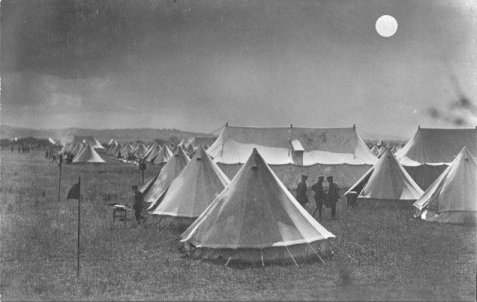
First World War Battles |
| Retreat from Mons - Marne, 1914 - Aisne, 1914 - La Bassee, 1914 - Armentieres, 1914 - Ypres, 1915, 17 - Gravenstafel - St. Julien - Frezenberg - Bellewaarde - Hooge, 1915 - Mount Sorrel - Somme, 1916, 18 - Delville Wood - Guillemont - Flers-Courcelette - Morval - Le Transloy - Ancre, 1916 - Bapaume, 1917, 18 - Arras, 1917 - Vimy, 1917 - Scarpe, 1917 - Arleux - Langemarck, 1917 - Menin Road - Polygon Wood - Broodseinde - Poelcappelle - Passchendaele - Cambrai, 1917, 18 - St. Quentin - Rosieres - Lys - Estaires - Hazebrouck - Albert, 1918 - Hindenburg Line - Havrincourt - Canal du Nord - Selle - Sambre - France and Flanders, 1914-1918 - Italy, 1917-18 - Struma - Doiran, 1917, 18 - Macedonia, 1915-18 - Gaza - Nebi Samwil - Jerusalem - Tell Asur - Megiddo - Sharon - Palestine, 1917-18 - Aden |
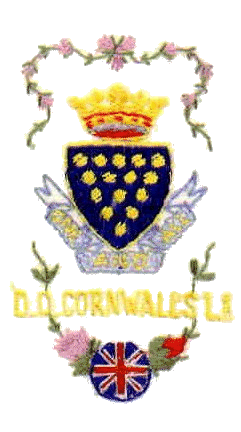
Duke of Cornwall's Light Infantry silk postcard, made in France for the Allied troops in World War 1 to send home as a souvenir
| 30 July to 22 September 1915 | Hooge (German liquid fire attack) & Bellewaarde |
| 13 August to 16 September 1916 | Somme, Delville Wood, Fleurs - Courcelette |
| 14 March to 5 April 1917 | Hindenburg Line, Arras, Scarpe, Ypres, Langemarch, Menin Road & Passchendaele |
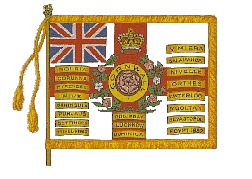
DCLI Colours: 1915 silk postcard
During WW1 William's home address was 43 Haseley Road, Handsworth, Birmingham 21 (QCFO/163/1) - being the address endorsed on his military identity tag.
DCLI Regimental Books
- The History of The Duke of Cornwall's Light Infantry 1914-1919 by Everard Wyrall. With a Foreward by H.R.H. The Prince of Wales and Duke of Cornwall, Colonel-in-Chief. London: Methuen & Co. Ltd., 1932, xix, 514 pp., portraits, plates, maps, plans. 9".
- The Duke of Cornwall's Light Infantry (The 32nd and 46th Regiments of Foot) by Robert Frederick Kinglake Goldsmith (hardcover, 122 pages, Published by Leo Cooper Ltd., Dimensions: 23 cm., ISBN: 0850520258) Part of the Famous Regiments Series. 34 Illustrations.
- History of the 1st D.C.L.I., 1914. Compiled from Official Records and other Sources. By. E. M. Channing-Renton, Lieutenant. Illustrated by Viscount French, John Hassall, R.I., Major T. A. Kendall and others. Alexandria; Studies Publications, 1924. x, 43, v pp., portrait, plates, maps. (The Duke of Cornwall's Light Infantry Great War History Series) 9".
- Notes on the History of The Duke of Cornwall's Light Infantry, compiled by Major J. H. T. Cornish-Bowden. Devonport: Hiorns and Miller. (1913-14). 7". No. 1 - The Raising of the Regiment and the Meaning of its name. 64pp. No. 2 - Early War Services. 55 pp.
- Images of England, The Duke of Cornwall's Light Infantry, compiled by Hugo White for the Duke of Cornwall's Light Infantry Museum. 2000. ISBN 0752418939. 128 pages, contains over 200 photographs.
- A Short History of The Duke of Cornwall's Light Infantry; its Formation and Services, 1702-1928, Devonport: Swiss & Co., Army Printers and Publishers, 1929. xvi, 63 pp. Coloured plate of colours. 6½".
- A Short History of The Duke of Cornwall's Light Infantry; its Formation and Services, 1702-1938, Plymouth: Underhill (Plymouth) Ltd., printers, 1939. xvi, 63pp., plate, 6 3/8". Another edition of the above book.
- The Duke of Cornwall's Light Infantry Regimental Standing Orders, publisher: Underhill (Plymouth) Ltd.
- The Red Feather: The Regimental Magazine of the 6th (Service) Battalion of the Duke of Cornwall's Light Infantry, printed by Drew, Union Street, Aldershot.
The Royal Berkshire Regiment (Princess Charlotte of Wales's)
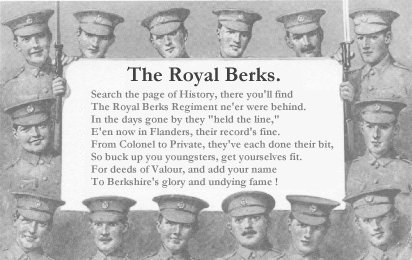 |
Raised in 1744 as Trelawney's Regiment (49th Foot in 1748) and in 1755 as the 2nd Battalion of the 19th Foot (66th Foot in 1758). These two regiments became the 1st and 2nd Battalions of Princess Charlotte's (Berkshire Regiment) in 1881 (Royal in 1885). As a royal regiment it wore blue facings. The regimental march is the "Dashing White Sergeant". Amalgamated in 1959 with the Wiltshire Regiment (Duke of Edinburgh's) to form The Duke of Edinburgh's Royal Regiment (Berkshire and Wiltshire). |
 |
The museum is located at The Wardrobe, 58 The Close, Salisbury, Wiltshire [01722 414536]. Hours: April - October daily 10.00 - 4.30; February, March, November Monday - Friday; Closed December & January. Curator: Major (Retd) J H Peters MBE. Memorials and retired Colours are housed at Forbury Gardens in Reading and in St Mary's, St George's and St Laurence's churches in Reading; St Helen's, Abingdon; Windsor Castle and Osborne House, Isle of Wight. |
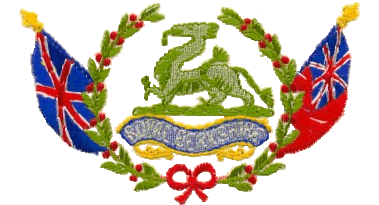 Royal Berkshire Regiment silk postcard, made in France for the Allied troops in World War 1 to send home as a souvenir. |
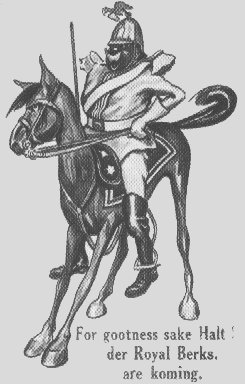 |
| First World War Battles | 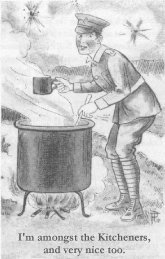 |
|
|---|---|---|
| 1914 | Mons | |
| 1914 - 1918 | Ypres | |
| 1916 - 1918 | Neuve Chapelle, Loos, Somme | |
| 1917 - 1918 | Arras | |
| 1917 | Cambrai | |
| 1917 - 1918 | Selle, Vittorio Veneto, Doiran | |
